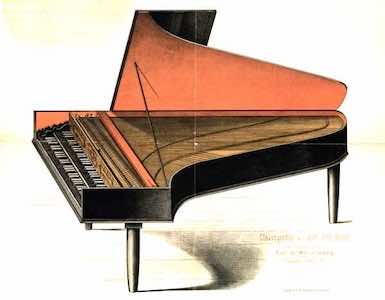Top > Instruments > Harpsichord
This site introduces unknown composer Emanuel Bach (C. P. E. Bach). This English version was translated from Japanese one by ChatGPT.
Harpsichord (Cembalo, Clavecin)
The Harpsichord is a type of keyboard instrument that was widely used from the late 15th century to the 18th century. It is known for its clear and brilliant tone, making it prominent in Baroque music. In Italy, it is called the Cembalo, and in France, it is known as the Clavecin. It is also recognized as one of the predecessors of the piano.

Structure and Mechanism
1. Plucking Mechanism
When a key is pressed on the harpsichord, a device called a “jack” moves, and its plectrum plucks the string to produce sound. This mechanism generates a consistent volume regardless of the key pressure.
2. Sound and Adjustment
The harpsichordʼs tone varies depending on the type of strings, tension, and the size of the instrument. It is characterized by its light and clear sound. Depending on the type, harpsichords can have either one or two keyboards.
3. Multiple Stops
Using devices called “stops,” players can change the tone and register, allowing for a variety of sound effects.
History and Role
1. 15th–16th Centuries
The harpsichord appeared during the Renaissance and developed in Italy and Flanders. Many compositions from this period take advantage of its tone, well-suited to polyphonic music.
2. Peak in the 17th–18th Centuries
The harpsichord became central to Baroque music, used in solo works, basso continuo, chamber music, and concertos. Notably, J. S. Bach, Handel, and Scarlatti composed masterpieces for the harpsichord.
3. Transition to the Piano
With the advent of the piano in the late 18th century, the harpsichord gradually fell out of use due to its limitations in dynamic expression.
The Modern Harpsichord
Today, the harpsichord has regained attention due to the revival of early music. It is performed by musicians and researchers dedicated to historical performance practices, offering an important way to experience Baroque instruments and styles.
Characteristics and Significance
The harpsichord is essential for performing and understanding Baroque music. Its tone and characteristics highlight the beauty of ornamentation and polyphony. Historically, it played a key role in the evolution of keyboard instruments and holds distinct cultural value.
ChatGPT4o was asked: “When was the harpsichord invented?”
The harpsichord is believed to have been invented between the late 14th and early 15th centuries. However, due to the lack of precise records about its exact invention date and inventor, details remain unclear. Its historical background includes:
-
Late 14th to Early 15th Century: The earliest records of the harpsichord appear in this period. It is thought that the first harpsichords were made in Italy and France.
-
Mid-15th Century: The harpsichordʼs shape and mechanism were established, and it began to be produced across Europe. Notable makers were active in Italy, Flanders, France, and Germany.
-
16th Century: The harpsichord became widely popular, inspiring many composers to create works for it. Italian and Flemish makers became renowned for producing high-quality instruments with refined sound and decoration.
-
17th to 18th Century: The harpsichord developed into a major instrument in Baroque music, becoming central to the keyboard repertoire alongside the clavichord and fortepiano. Composers like François Couperin and Johann Sebastian Bach composed extensively for it.
Early harpsichords were relatively simple, but over time they evolved into more complex instruments with rich decorations and diverse tonal capabilities. Their distinctive sound and ornamental nature greatly influenced European music from the Renaissance to the Baroque period.